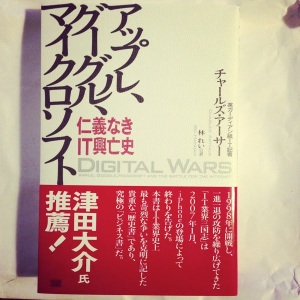The publishers are keen on a second edition of Digital Wars – it’s “done so well [in sales terms]”, they say.
 Which is great to hear, though of course that also means adding new stuff. And taking some stuff out as well.
Which is great to hear, though of course that also means adding new stuff. And taking some stuff out as well.
The question is: what?
There’s room for about 5,000 new words, apparently. The book as it stands is about 90.000 words. So it’s not a huge change. The main narrative would remain the same: prologue, antitrust, search, digital music, smartphones, tablets, epilogue.
5,000 words translates to about 10 sides.
An obvious reaction is “add in Facebook, and Twitter, because they’re really big, and you know, there’s lot of people on them.” But I don’t think they fit into the narrative of these three companies. Facebook gets a mention, but only in the context of Microsoft’s pursuit of search.
There’s some updating to do about Google and antitrust; the smartphone patent wars; Microsoft and Bing; the position of the smartphone wars now (and BlackBerry’s perilous position, and Nokia’s similarly wobbly situation).
But for people who have read it, are there parts that you wanted to see less of? Or more of?
One of the things that I wanted to get more of into the first edition, but couldn’t (for space) was the issue of the supply chain. The reason why Apple and Samsung dominate now is that they have such tight control over the supply chain. Samsung has it because it makes its own stuff; Apple, because it has used its cash pile to tie up production.
Anyhow, your suggestions welcome for what should be in the new edition. But remember: it needs to fit into the narrative.

Hi Charles,
I really enjoyed the book (first edition… sounds like “of many”).
When I say that a chapter could focus on “collateral damage”, I mean that the “struggle” occurring between the big players pulls in other firms (everything from manufacturing of handsets to application and software development). Similar to a real war, some of these firms thrive (and make millions when their idea is purchased by one of the big 3), some are pillaged for their resources as “protectorates” and some disappear (“wiped from the map”… companies that EITHER got purchased then closed down, or who “backed the wrong horse” and saw their market share slump as a result).
Hope this gives some “food for thought”.
Regards,
Andrew
Talking about this earlier today with my dad: What about organisations that manage to play all sides? (AMD/Nvidia?)